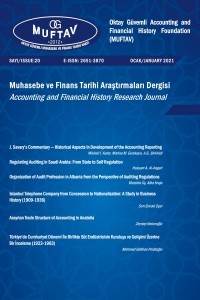Meşrutiyet Dönemi Kosova Vilayeti Mali Verileri Üzerine Bir Değerlendirme (*)
İnceleme dönemimizde Osmanlı Devleti taşra teşkilatlarının malî durumunu ortaya koyan en derli toplu kaynaklar; bölgeyle ilgili tutulan bütçe ve/veya bilânço defterleridir. Kosova Eyaleti’nin bu varidat ve masarifat bütçeleri verilerinin ortaya konması bölge ile yapılacak sosyo-ekonomik çalışmalara da ana kaynaklık teşkil edecektir. Bu çalışmayla, Kosova Eyaleti’nin 1878–1908 yılları arasındaki bütçe ve/veya bilânço defterleri incelenerek, eyaletin ekonomik durumu hakkında genel bir fikir elde edilmeye çalışılmıştır. Ayrıca bu defterlere girmeyen vakıf gelir ve giderleri de tespit edilerek, bölgede elde edilen toplam gelir ve giderlere ulaşılması hedeflenmiştir. Elde edilen mali veriler nüfusla karşılaştırılarak kişi başına düşen milli gelirler ve gider verileriyle, Kosova Eyaleti’nin ülke içerisindeki ekonomik durumu hakkında bir değerlendirme yapma fırsatı yakalanmıştır. Bu defterlere göre bölgenin en önemli gelir kalemini aşar, ağnam ve virgü gelirleri oluşturmaktadır. En önemli gider kalemleri ise dâhiliye, maarif ve nizamiye kalemleridir. Kişi başına düşen gelir ve giderlerin tespiti ile bölgelerarası gelişmişlik düzeyinin belirlenmesi mümkün olmuştur. Buna göre Kosova Eyaleti’nde kişi başına düşen gelir 42, masraf miktarı ise 21 kuruş civarındadır. Gelir gider muvazenesi 21 kuruş fazlalık vermektedir. Bu rakamlar Osmanlı Devleti ortalaması olan 45 kuruşluk gelir ile 26 kuruşluk masraf ortalamasına yakındır.
An Evaluation on Financial Data of Kosovo Province in Constitutional Monarchy Period
The most respectable resources presenting the financial status of Ottoman provincial organizations are budget and/or balance books recorded for the related province. Presenting income and expense budget data of the Kosovo Province will be one of the main references for socioeconomic studies to be carried on this region. In the present study, examining the budget and/or balance books recorded between 1878 and 1908 for the Kosovo province, we attempted to get a general idea about the financial status of the province. Moreover, we aimed to find out the total income and expense by determining the income and expense of foundations which were not recorded in the balance books. Comparing obtained financial data with the population of the province and calculatingincomeper capita gave the researcher the chance to evaluatefinancial status of Kosovo. According to these balance books, the most important income items were composed of tithe, cattle tax and virgü (a kind of special annual income tax). On the other hand, the most significant expenditure items were internal affairs, education and military. The gathered data made it possible to ascertain the level of development among the regions by determining income and expenditure per capita. Thus, in Kosovo Province, income per capita was around 42 kurus, expenditure was around 21 kurus. The balance of income and expenditure showed a surplus of 21 kurus. These figures are close to average of Ottoman Empire which was 45 kurus income per capita and 26 kurus expenditure.
